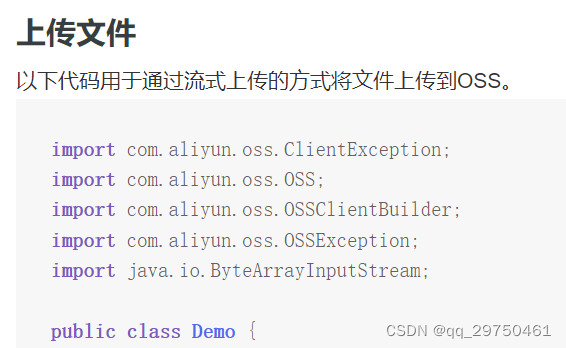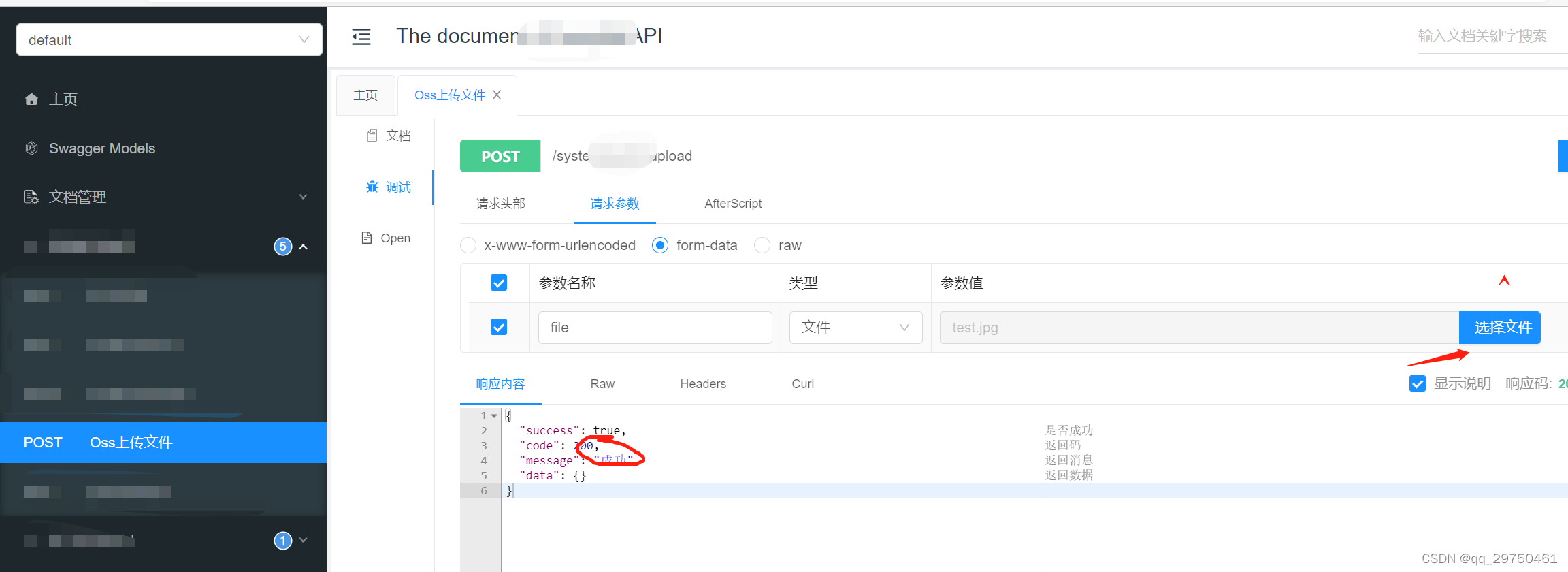关于OSS的基础使用,可以参看下前面的文章 点击进入,这里主要介绍下SpringBoot怎样操作阿里云OSS实现文件上传。
1 ServiceImpl.java 代码,可参看官方文档 进入

这个是官方文档中的代码,可以看到这里是实现上传一段文字 : “Hello OSS”
import com.aliyun.oss.ClientException;
import com.aliyun.oss.OSS;
import com.aliyun.oss.OSSClientBuilder;
import com.aliyun.oss.OSSException;
import java.io.ByteArrayInputStream;
public class Demo {
public static void main(String[] args) throws Exception {
// Endpoint以华东1(杭州)为例,其它Region请按实际情况填写。
String endpoint = "https://oss-cn-hangzhou.aliyuncs.com";
// 阿里云账号AccessKey拥有所有API的访问权限,风险很高。强烈建议您创建并使用RAM用户进行API访问或日常运维,请登录RAM控制台创建RAM用户。
String accessKeyId = "yourAccessKeyId";
String accessKeySecret = "yourAccessKeySecret";
// 填写Bucket名称,例如examplebucket。
String bucketName = "examplebucket";
// 填写Object完整路径,例如exampledir/exampleobject.txt。Object完整路径中不能包含Bucket名称。
String objectName = "exampledir/exampleobject.txt";
// 创建OSSClient实例。
OSS ossClient = new OSSClientBuilder().build(endpoint, accessKeyId, accessKeySecret);
try {
String content = "Hello OSS";
ossClient.putObject(bucketName, objectName, new ByteArrayInputStream(content.getBytes()));
} catch (OSSException oe) {
System.out.println("Caught an OSSException, which means your request made it to OSS, "
+ "but was rejected with an error response for some reason.");
System.out.println("Error Message:" + oe.getErrorMessage());
System.out.println("Error Code:" + oe.getErrorCode());
System.out.println("Request ID:" + oe.getRequestId());
System.out.println("Host ID:" + oe.getHostId());
} catch (ClientException ce) {
System.out.println("Caught an ClientException, which means the client encountered "
+ "a serious internal problem while trying to communicate with OSS, "
+ "such as not being able to access the network.");
System.out.println("Error Message:" + ce.getMessage());
} finally {
if (ossClient != null) {
ossClient.shutdown();
}
}
}
}
在ServiceImpl中添加统一的身份认证方法
我们参看了官方文档会发现,每个操作OSS的方法都会有以下的身份认证前缀,这个如果每个方法都加上下面的内容,显得代码较冗余。
// Endpoint以华东1(杭州)为例,其它Region请按实际情况填写。
String endpoint = "https://oss-cn-hangzhou.aliyuncs.com";
// 阿里云账号AccessKey拥有所有API的访问权限,风险很高。强烈建议您创建并使用RAM用户进行API访问或日常运维,请登录RAM控制台创建RAM用户。
String accessKeyId = "yourAccessKeyId";
String accessKeySecret = "yourAccessKeySecret";
// 填写Bucket名称,例如examplebucket。
String bucketName = "examplebucket";
所以我们配置下面的代码段,具体的代码可以参看 之前的文章,该方法可以在Bean初始化后进行加载,当然也可以使用一个简单的 非静态代码块来实现。
//首先定义相关的类全局属性
//存放endpoint地址
private String endpoint;
private String accessKeyId;
private String accessKeySecret;
private String bucketName;
//初始化Bean之后需要进行的操作
@Override
public void afterPropertiesSet() throws Exception {
Endpoint以杭州为例,其它Region请按实际情况填写。
endpoint = ossEntity.getEndpoint();
阿里云主账号AccessKey拥有所有API的访问权限,风险很高。强烈建议您创建并使用RAM账号进行API访问或日常运维,请登录RAM控制台创建RAM账号。
accessKeyId = ossEntity.getAccessKeyId();
accessKeySecret = ossEntity.getAccessKeySecret();
bucketName = ossEntity.getBucketName();
}
有了以上的定义后,其实可以将 upload 方法写为
public String upload(MultipartFile file){
// 填写Object完整路径,例如"avater/test.jpg"。Object完整路径中不能包含Bucket名称。这个路径会在 OSS 后台生成相应的目录和文件
String objectName = "avater/test.jpg";
// 创建OSSClient实例。
OSS ossClient = new OSSClientBuilder().build(endpoint, accessKeyId, accessKeySecret);
try {
//String content = "Hello OSS";
try{
ossClient.putObject(bucketName, objectName, file.getInputStream());
}catch (IOException iOException){
System.out.println("Error Message:" + iOException.getMessage());
}
//ossClient.putObject(bucketName, objectName, new ByteArrayInputStream(content.getBytes()));
} catch (OSSException oe) {
System.out.println("Caught an OSSException, which means your request made it to OSS, "
+ "but was rejected with an error response for some reason.");
System.out.println("Error Message:" + oe.getErrorMessage());
System.out.println("Error Code:" + oe.getErrorCode());
System.out.println("Request ID:" + oe.getRequestId());
System.out.println("Host ID:" + oe.getHostId());
} catch (ClientException ce) {
System.out.println("Caught an ClientException, which means the client encountered "
+ "a serious internal problem while trying to communicate with OSS, "
+ "such as not being able to access the network.");
System.out.println("Error Message:" + ce.getMessage());
} finally {
if (ossClient != null) {
ossClient.shutdown();
}
}
return "成功";
}
编写Controller层测试代码
@Autowired
private AliOssService aliOssService;
@ApiOperation("Oss上传文件")
@PostMapping("/upload")
public Result upload(MultipartFile file){
String upload= aliOssService.upload(file);
return Result.ok().message(upload);
}
发布工程,访问测试

OSS控制台


后台测试成功